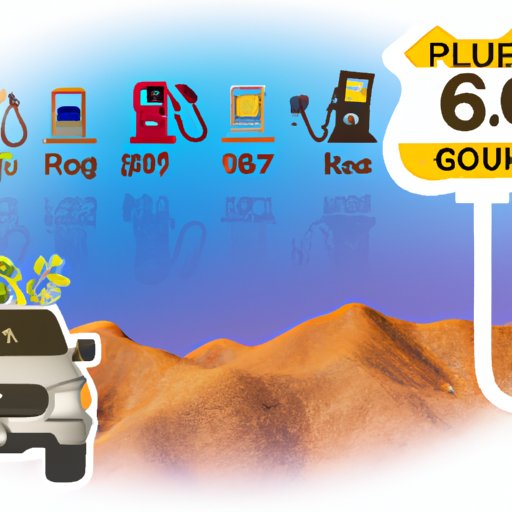Introduction
If you’re planning a long road trip, you need to make sure you have enough fuel to get you there and back. Knowing exactly how much fuel you’ll need can be tricky, as there are a number of factors at play. In this article, we’ll examine the cost of fuel for a road trip, how to estimate the amount of gas you’ll need, and strategies for maximizing fuel efficiency on your next journey.

Calculating the Cost of Fuel for a Road Trip
The first step in estimating the cost of fuel for a road trip is to determine the gas mileage of your vehicle. This can vary depending on the type of car you drive and the condition of the engine. Generally speaking, newer vehicles with well-maintained engines tend to have higher gas mileage than older models.
Once you’ve determined the gas mileage of your vehicle, you can begin to calculate the cost of fuel for your trip. You should factor in the price of gasoline in the areas you’ll be traveling through, as well as any other variables such as terrain, elevation, wind resistance, and driving speed. All of these can affect your vehicle’s fuel efficiency.
How to Estimate the Amount of Gas You’ll Need for Your Next Journey
Once you’ve taken into account all the variables that can affect your vehicle’s fuel efficiency, you can begin to estimate the amount of gas you’ll need for your trip. The first step is to determine the length of your trip. This includes the total distance you’ll be traveling, as well as any stops you plan to make along the way.
Next, you’ll need to calculate the total distance you’ll be traveling. To do this, simply add up the distances between each of your destinations. Once you have the total distance, you can then use your vehicle’s gas mileage to estimate the amount of gas you’ll need. Simply divide the total distance by your vehicle’s gas mileage to get an estimate of the amount of fuel you’ll need for your trip.

Planning Ahead: An Overview of Fuel Requirements for Long Trips
When planning a long road trip, it’s important to take into account any potential contingencies that could arise. For example, if you’re traveling through an area with limited access to gas stations, you may need to factor in extra fuel in case of an emergency. Additionally, you should be aware of any potential changes in weather or traffic conditions that could affect your vehicle’s fuel efficiency.
It’s also important to consider the cost of fuel when planning a road trip. Gas prices can vary significantly from state to state, so you should research the average cost of fuel in the areas you’ll be traveling through. This will help you budget for fuel costs and ensure you don’t end up spending more than you need to.
Tips for Conserving Fuel During a Road Trip
In addition to calculating the amount of fuel you’ll need for your trip, there are a few other steps you can take to maximize fuel efficiency. First, you should make sure your vehicle is running efficiently. Regularly check your oil and tire pressure, and make sure your air filter is clean. This will help ensure your vehicle is getting the most out of every drop of fuel.
You should also plan your route efficiently. Whenever possible, try to avoid congested roads and highways. This will reduce the amount of time you spend idling in traffic, saving you fuel in the process. Additionally, look for routes with fewer hills and curves, as these can also reduce fuel efficiency.

Strategies for Maximizing Fuel Efficiency on Your Next Trip
Once you’ve taken all the necessary steps to ensure your vehicle is running efficiently, you can begin to focus on your own driving habits. Avoid rapid acceleration and deceleration, as these can significantly decrease fuel efficiency. Additionally, try to maintain a steady speed whenever possible, as this can help reduce fuel consumption.
Finally, keep track of your fuel usage. By monitoring your fuel consumption, you can identify any areas where you may be able to improve your fuel efficiency. This can help you adjust your driving habits and save money in the long run.
Conclusion
Planning a road trip can be an exciting adventure, but it’s important to make sure you have enough fuel to get you there and back. Calculating the cost of fuel for a road trip requires taking into account a number of variables, such as gas mileage, terrain, elevation, and driving speed. Additionally, you should plan ahead and factor in any contingencies that could arise. Finally, there are a number of strategies you can use to maximize fuel efficiency on your next journey, such as maintaining vehicle efficiency, planning routes efficiently, and driving habits.
(Note: Is this article not meeting your expectations? Do you have knowledge or insights to share? Unlock new opportunities and expand your reach by joining our authors team. Click Registration to join us and share your expertise with our readers.)
